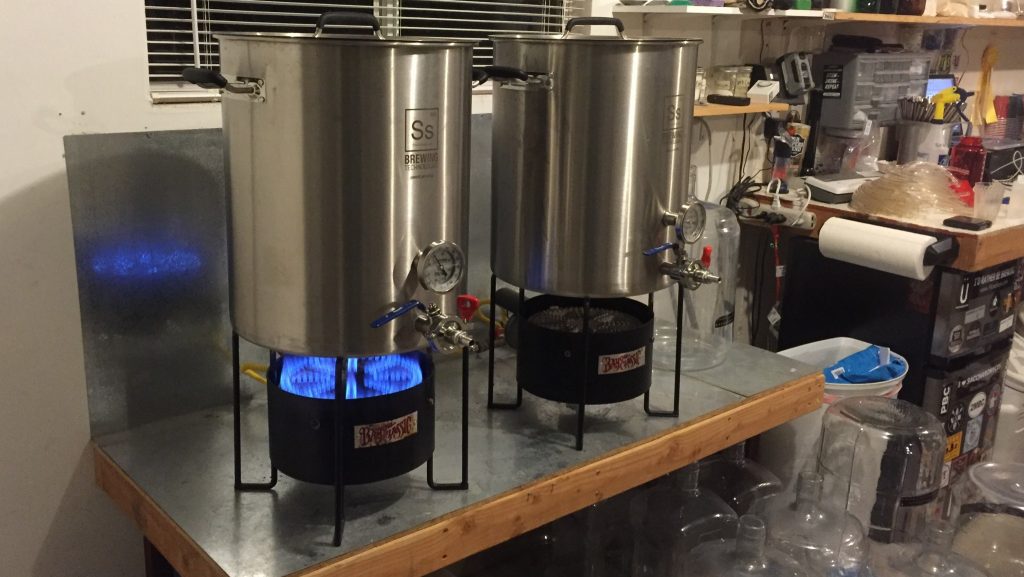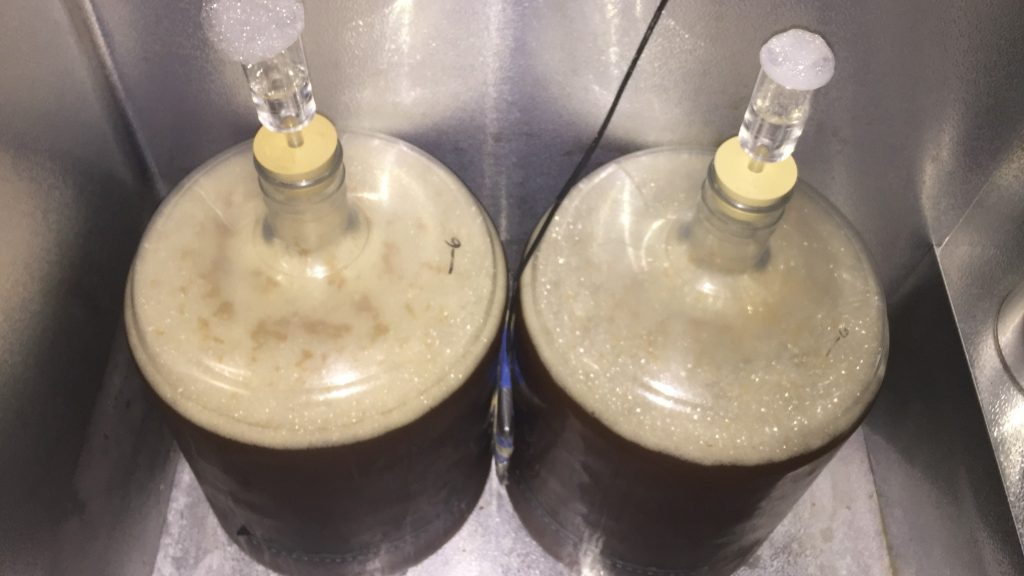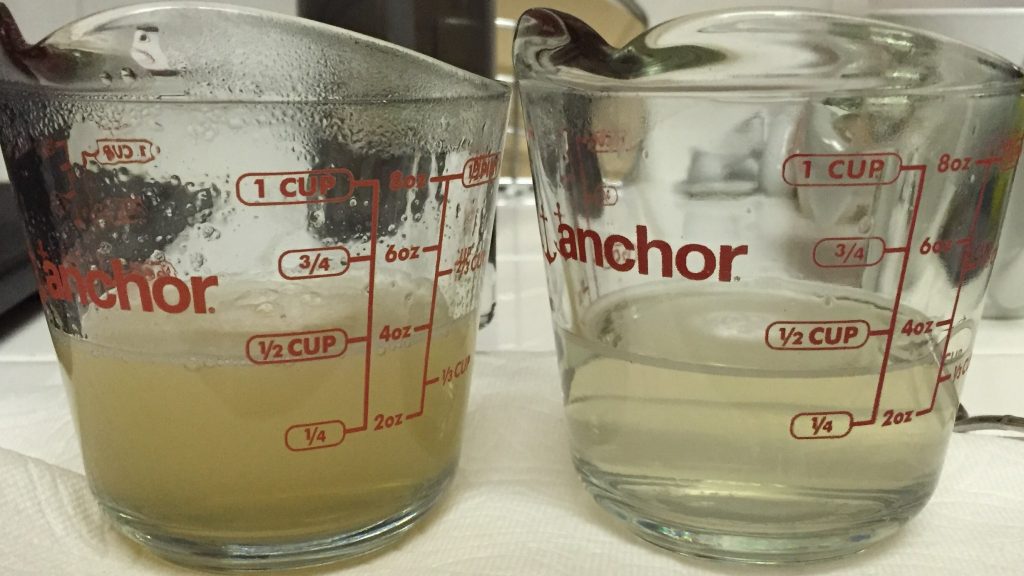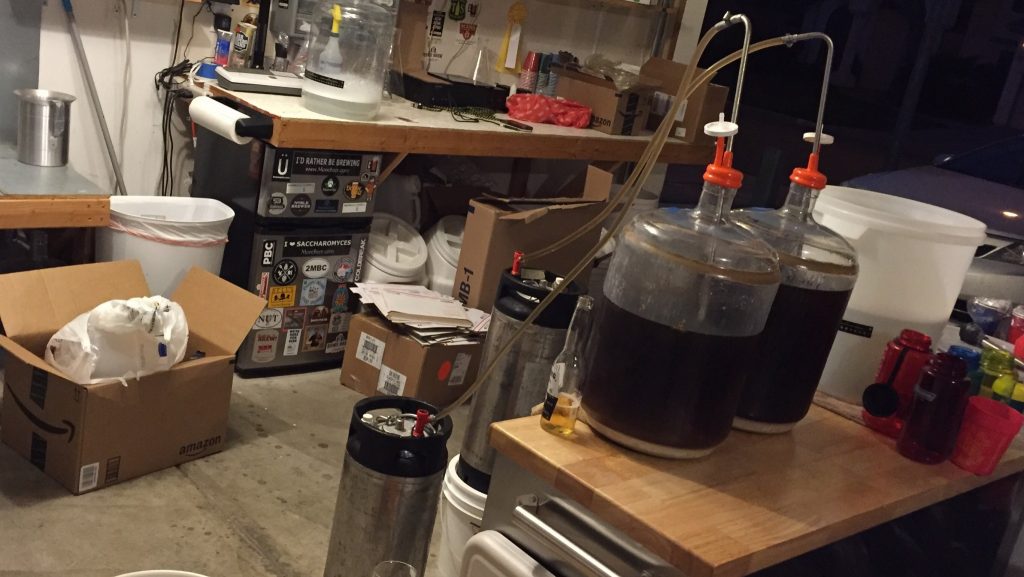Author: Marshall Schott
At this point, Brülosophy regulars are well aware that we’re big fans of using gelatin as a beer clarifier. Besides being incredibly easy and quick, it’s super cheap– I still have half of a box of 32 pouches left that I ordered back in November of 2014, and I brew quite a bit. By my calculations, this puts me at just under $0.10 worth of gelatin per 5 gallon batch, a small price for those of us who prefer our beer to clear in short time.
During a conversation I had about gelatin with John Palmer a few months ago, he asked if I’d ever used more than the 1/2 teaspoon per 5 gallon ratio I discussed in the first gelatin xBmt article. Seeing no need to fix something that isn’t broken, I admitted I’d never strayed from this method, but that I’d heard from many brewers who used amounts ranging from 1 teaspoon to a full tablespoon, all who reported success. It was around this time the first Short & Shoddy batch was done fermenting and I added the same gelatin solution I use for 5 gallon batches to the 1.75 gallons of beer. Later that day, it was crystal clear, leaving me curious if the larger amount of gelatin somehow expedited the clearing process.
| PURPOSE |
To evaluate the impact the amount of gelatin used as a fining has on beer.
| METHODS |
I needed to get my beers brewed for the quickly approaching National Homebrew Competition, and due to a friendly rivalry with bloggers Derek Springer from the Five Blades Brewing and Dan Paris from the InBounds Brewing, I designed a Vienna Lager recipe that differed greatly from any I’d made before. Since I rarely do anything without a little twist, I decided to submit this beer into a few different categories.
Lying In Wait
Recipe Details
| Batch Size | Boil Time | IBU | SRM | Est. OG | Est. FG | ABV |
|---|---|---|---|---|---|---|
| 11 gal | 60 min | 19.8 IBUs | 12.2 SRM | 1.052 | 1.012 | 5.2 % |
| Actuals | 1.053 | 1.01 | 5.6 % | |||
Fermentables
| Name | Amount | % |
|---|---|---|
| Vienna Malt (Gambrinus) | 20 lbs | 96.97 |
| Pale Chocolate Malt | 10 oz | 3.03 |
Hops
| Name | Amount | Time | Use | Form | Alpha % |
|---|---|---|---|---|---|
| Magnum | 26 g | 60 min | Boil | Pellet | 11.2 |
| Select Spalt | 30 g | 10 min | Boil | Pellet | 3.1 |
Yeast
| Name | Lab | Attenuation | Temperature |
|---|---|---|---|
| German Bock Lager (WLP833) | White Labs | 73% | 48°F - 55°F |
Download
| Download this recipe's BeerXML file |
Two days before brewing, I threw together a single large starter using 2 packs of WLP833 German Bock yeast.
The following evening, I gathered my liquor, adding the minerals and acid per the Bru’n Water spreadsheet recommendations, then milled my grain in preparation for brewing the next morning.
On brew day, I hit the flame under my strike water kettle then retreated inside to start a pot of coffee.
Within 15 minutes, the strike water was to temp and I mashed in, nailing my target mash temperature on the nose.

While I have great faith in Bru’n Water, I like to periodically measure mash pH readings just to be sure everything is still on point, and since I’d be submitting this beer to competition, I figured it was a good one to test. About 10 minutes after mashing in, I pulled a small sample into a cold glass, chilled it to room temp, and confirmed I’d hit my desired pH.
After a 45 minute saccharification rest, I collected the first runnings, performed a batch sparge, then quickly brought the full volume of wort up to a boil.
The 1 hour boil proceeded like normal with hops being added according to the recipe. Once complete, I quickly chilled the wort to 75°F/24°C, split it evenly between two sanitized 6 gallon PET carboys, then placed them in my chamber controlled to 50°F/10°C to finish chilling. Believe it or not, I still ferment some lagers cool. It took about 6 hours for the worts to stabilize at my target fermentation temperature, at which point I pitched an equal amount of yeast starter into each fermentor. Signs of activity were present 18 hours later.
The beers fermented and, no big surprise since nothing was different at this point, appeared the same throughout. After 4 days of activity, I ramped the temperature in the chamber to 68°F/20°C and by 1 week post-pitch both beers appeared to have finished fermenting. I let them sit a couple more days before taking an initial hydrometer sample, which showed both had dropped to the same target FG.
Noticing no off-flavors at this point, I set the chamber temperature to 32°F/0°C and began cold crashing. The following afternoon, it was time to introduce the xBmt variable. Having heard stories of people successfully using 1 packet of gelatin, which amounts to 2.5 teaspoons (7 grams), I was curious to see if even more might expedite the clarifying effects and opted to dose the high amount batch with a bit more.
For this xBmt, I would be comparing my normal gelatin dosage of 1/2 teaspoon per 5 gallons of beer to 2 full packets, approximately 10x the normal amount, both of which I dissolved in 1/4 cup of hot water. The difference in appearance was quite apparent.
The gelatin solutions were added to the beers and the carboys gently swirled to ensure adequate distribution. Anxious to see how things were moving along, I pulled small samples from each and was surprised with what I observed.
While neither batch was bright, the normal amount beer seemed to be more clear than the high amount batch. I let the beers lager another 2 days then proceeded with packaging.
As the carboys slowly emptied, I noticed something stuck to the inside of the one the high amount batch was fermented in. It looked like a blob of… Jell-O!
The full kegs were placed in my 38°F/3°C keezer where they were hit with 40 psi of CO2. Twenty hours later, I purged the kegs and reduced to my preferred serving pressure of 14 psi. Another day later, after tossing the first few ounces from each keg, I pulled small samples to compare clarity differences.

The standard amount beer continued to show signs of better clarity while the high amount beer maintained a noticeable haze. Could this be result of the “fluffy bottoms” theory I’d read about? If so, I’d expect the high amount beer to be demonstrably briter as I continued to rid that keg of the fluff. I let both sit another full week before presenting them to tasters for evaluation, the clarity difference at this point only more amplified.

| RESULTS |
In all, a panel of 19 people consisting of BJCP judges, experienced homebrewers, and craft beer drinkers participated in this xBmt. Each taster was blindly served 1 sample of the beer fined with a normal amount of gelatin and 2 samples of the beer dosed with a large amount in opaque cups then asked to identify the one that was different. Given the sample size, 11 tasters (p<0.05) would have had to accurately identify the unique sample in order to reach statistical significance. All said and done, only 8 participants (p=0.28) made the correct selection, suggesting a beer fined with a normal amount (1/2 teaspoon) of gelatin is indistinguishable from one fined with 10x the amount.
Following each tasting session, I poured the samples from the opaque cups into clear glasses and asked the participants to again select the sample they thought was different based on appearance alone. Every single one easily identified the odd-beer-out, many expressing surprise to discover it differed from their original selection that did not account for appearance.
Preference ratings among those who were correct on the triangle test, meaningless as they may be given the xBmt results, were split 4-4 between the beers.
| DISCUSSION |
The issue of beer clarity, or perhaps more accurately beer haze, has been the subject of much debate lately with one camp believing fining and filtering reduces quality while another camp claims the opposite. The main purpose of this xBmt was to evaluate the impact of gelatin amount on beer, and while obvious differences in clarity were observed between the two conditions, participants were unable to reliably distinguish one from the other. This, to me, is where the most interesting implications lie, as it adds to evidence that utilizing fining agents, at least gelatin, to assist in clarity is not detrimental to the beer’s overall quality. In fact…
I packaged this beer a mere 5 weeks after brewing it, sending 12 bottles off to Seattle to be judged in 4 different categories of the National Homebrew Competition. One of the seemingly more organized judging sites, I received word a couple weeks later that my Märzen scored well enough to advance to the second round! When I received my scoresheets in the mail, I was pleased to discover the judges thoroughly enjoyed the beer and gave it a combined 40 points, which put it in third place!
Are you a finer, a filterer, or a long-time lagerer? What has your experience been using different amounts of gelatin or other finings? Please share your thoughts in the comments section below!
Support Brülosophy In Style!
All designs are available in various colors and sizes on Amazon!
Follow Brülosophy on:
FACEBOOK | TWITTER | INSTAGRAM
If you enjoy this stuff and feel compelled to support Brulosophy.com, please check out the Support Us page for details on how you can very easily do so. Thanks!























54 thoughts on “exBEERiment | The Gelatin Effect: Impact Fining With A Large Amount Of Gelatin Has On Vienna Lager”
Interesting that you mentioned Fluffy Bottoms. As I read your recipe comprised of Vienna/Chocolate Malt, I had an inkling of the results. In my experience, with higher sugars/darker grist’s, using less finings helps, but filtering in conjunction w/finings seems to precipitate a clearer beer sooner. Nothing beats time however.
Gelatin beats time alone in my book!
> Gelatin beats time alone in my book!
Agreed. Gelatin in conjunction w/time will yield sparkling clarity. But, we already are aware of each others opinion’s on aging w/regards to flavors 😉
Indeed. I’m still trying to design a few xBmts where time is one of the variables of investigation, but isolating it is proving quite difficult. For example, traditional vs. quick lager method is one I really want to get done, but unless I do separate brew days, the quick lager will be “lagering” in the keezer for 4+ weeks, potentially ameliorating any effect. Another option would be to do separate brew days split by 4 weeks or so, but then I’d have to contend with the fact the grains used were 4 weeks older at time of brewing. I think the latter is the best route, but I’m still ambivalent.
I think age of grain would be a really interesting one. With all the factors that go into a beer’s flavor, I wouldn’t expect it to make a difference even if the grain was a month older on one batch…but two months? Three? Or maybe I’m entirely wrong, and even just a week can make a difference!
This is in regards to the “grain being 4 weeks older” downthread about quick and traditional lagering (the comment system isn’t letting me reply to anything further downthread directly): I would think that’s really a moot point, seeing as barley is only harvested twice a year and malted in lots from there; point being, most malts – until milled – are pretty stable over the course of *months* let a lone a single month. I would be more concerned about all the other variables introduced by two separate brew sessions so far apart (though even then, if you have good controls on your environment and system, shouldn’t be too problematic).
Marshal,
What about brewing 11 gallons and not pitching yeast to half until the other has been lagering for 4 weeks.
That’s an option, but an extraneous variable would be “time sitting without yeast,” and I tend to think that increases the risk of something else taking over… despite my neurotic cleaning/sanitation practices.
Louis Pasteur disproved spontaneous generation of microbes by leaving sterile media in a gooseneck flask forever. If your stuff is sterile, there’s nothing to worry about. Wonder if it goes stale, though? Leave it in a CO2-purged keg?
3rd place huh? That’s alright, I guess.
Hello
I use a tsp of gelatin and the result was clear beer in no time. I must admit that I have only just started using gelatin but based on the results thus far I don’t plan on changing the amount. Cheers!
Josh – KAHJE Beer Co.
Ray uses 1 tsp as well.
Out of curiosity, how did the beer score in the other three categories?
I’m working on an article where I discuss precisely this, just want to make sure I don’t come across too dickish… stay tuned 🙂
unfortunately gelatin isn’t vegetarian, neither is isinglass. I’m a vegetarian
They do sell vegan friendly clarifiers, although the name escapes me at they moment.
BioFine Clear and ClarityFerm are probably the most popular, then there’s agar agar, which we’ve not yet used.
Look into a product called Polyclar, which is PVPP and of course vegetarian.
I wonder if this is a case of the gelatin stumbling over itself. The Jello Beer Blob could indicate that the proteins were kept trapped in suspension bit longer then normal. If this is the case then you, Marshall, may have created the “golden ratio” of gelatin to gallons of beer. Anything more slows the process and anything less is ineffective. Would be interesting to see if you get similar results at 10 and 15 gallons.
I’m wondering if using the same amount (1/4 cup) of water for both batches of gelatin had any effect. It was obviously thicker in the measuring cup. Perhaps the jello blob wouldn’t of happened if 2 packets were mixed into a full cup of water instead. Also, you said it was mixed into hot water, do you not mix with cold water and then microwave to get to 150 like before?
It actually wasn’t too much thicker, I expected it to be and would have added more water to both of it was. But maybe dilution amount did play a role.
I start with hot tap then microwave in 15 second bursts until dissolved.
That’s a good point. I always use a full packet of gelatin, but I also use a full cup of water with it.
I always use a full packet, mostly because i’m too lazy to measure it out. I’ve had pretty good luck with very clear beers. So much so that a brewer friend of mine recently asked me how i get my beer so clear. I wonder if there is a certain level where it becomes too much and congeals in the beer.
After reading this I’m tempted to try using less, but I’m not sure I could get much clearer. The stuff is so cheap as you said that the wasted amount isn’t really a factor.
You might try using less only to save some money on gelatin, particularly if using more doesn’t seem to make much of a difference. I get about 3.5 batches out of a single packet 🙂
hi marshal,
pitch rate around 1million cells/plato/mL ?
am I right?
Hi Luis! Right around that, indeed.
I use 1/2 teaspoon as well with a about half a cup of water and heat to 150f. Bright beers! Can”t beat knox gelatin . Priceless!
Is this 1/2 teaspoon in a 5G batch?
The Jello blob reminds me of the time a gelatin’d a beer, but got the gelatin a bit too warm (at least I think that’s why) and nearly couldn’t get the beer out of the keg. luckily 50psi was enough to push the ‘beer snot’ through. Very lovely clear beer after that!
I’ve heard from a trusted scientist friend that you can’t really get gelatins too warm, even boiling won’t denature (or whatever) it.
Love your stuff man. I’m an organic chemist and know what’s going on with these little molecule. For another day! Ever consider adding the gelatin to the boil?
Thanks!
I have never considered that, might be interesting to try 🙂
Do you think that because of the density of your 2 pkg addition, meaning it was way less diluted, that that is what created the blob? And thereby that gelatin did not get dispersed? I wonder what would happen if you raised the water level accordingly so that the density was the same but the volume was greater in one batch.Then maybe it would dissolve into the beer better.
As usual my brain finds more questions in your exbeeriments!
I think the beer with the higher amount of gelatin should have had the gelatin dissolved in more water. Per Siebel classes and the lager book I use the following procedures. What do you think?
Fining With Gelatin
1. Use 1g per gallon of beer in 60ml of cold water
2. Boil and cool water to room temp.
3. Gently mix Gelatin and water and let it rehydrate for 1 hour
4. Heat to 70C
5. Let it sit for 15 minutes
6. Return and stir up the mixture very well
7. Pitch to previously crashed beer
8. Purge CO2 from keg
9. Shake or circulate the beer to blend evenly
10. Let sit for at least 12 hours. Long is better.
I figured as longs as the gelatin was fully dissolved, as it was, it wouldn’t much matter… maybe I was wrong.
The jello blob might be a sign that it wasn’t fully dissolved. For those who didn’t grow up with the metric system, but who have access to an accurate scale: 1 ml water weighs 1 gram. I find it more accurate and easier to just weigh the water for the calculations. A 5 gal batch would need (5 gal x 60 ml) = 300 gram water or about 3/4 US cup.
Long live gelatin! I can’t wait for a future gelatin vs agar exbeeriment! There might be an issue there as far as charge goes, as fining agents generally have large molecules that are positively charged, while agar has a negative charge. Exbeeriment will tell.
The gelatin was completely dissolved in the water and really not that much more viscous than the standard amount solution.
I am a follower of your page from Spain. I have a question about lager yeast. At what temperature do you do the starter? Fermentation temperature 50F o higher?
Thanks and regards Dani
Room temp– 68-75F.
I wonder if there’s something that can be added to over-gelatined beer to get the excess to precipitate out. Wet rice hulls? More hops?
what water target profile did you use?
I believe it was close to Amber balanced in Bru’n Water, but I only use gypsum, CaCl, and lactic acid.
I was really hoping that the heavy dose beer actually turned into Jello. Damn.
Interesting xBMT. Marshall’s love of WLP090 inspired me to try it on a West Coast IPA I brewed last weekend. I think it’s time to start using the gelatin to get the clarity I want this beer to have.
My girlfriend loves cows and refuses to eat beef. I’ll have to add it on the sly.
Hey Marshall,
Could you describe your fermentation chamber. I am thinking of building a dedicated fermentation chamber and looking for some ideas and suggestions.
Cheers and great xBMT.
I have 2, both chest freezers with temperature controllers. Pretty simple and cheap if you find one used.
I’ve been using your technique for some time. I make an Okinawa-inspired lager with rice syrup solids and sorache ace. It comes out commercial crystal clear. Thanks a ton. And I love my Brülosophy hoodie.
Cheers!
Nice article! Was the starter on the stir plate at room temp, i.e., pitched into colder wort? Also, did you cold crash the starter and decant or just swirl and pour into the fermenters? Thanks!
Hey man, great blog!!!
I have a question for you about ph, I have read that ph at room temperature goes up, so having a ph of 5.2 at room temperature, is that correct? I use EZ water, and it says that the desire ph range at room temperature is between 5.4-5.6
Thanks for the information.
Thanks!
I chill my pH samples to ~66F before taking readings, and over the years I’ve learned I prefer the crispness I get from a mash pH of ~5.2.
So here is a question. What if you xBmnt with gel fining warm, where the cold haze is in solution and not a haze, and fining cold, where the gel can pull down the cold haze too.
Cool just before serving, so one has the mystical cold haze in it.
Hopefully this can test if the impact of the haze
Hey Marshall, interesting experiment! Clearly less is more when it comes to gelatin and clarity, but it’s nice to know that there aren’t any detrimental consequences of using more. I will say that I’ve always used the whole 11g packet of Knox gelatin for a 5gal batch and obtained the clarity I’ve desired (then I don’t need to measure anything out), but had wondered if I’ve lost any flavour aspect to it. This last beer I brewed, I fermented it on top of a yeast cake that I had previously gelatined, and although I gelatined this beer as well (and got amazing clarity), it made me wonder if one can add gelatin prefermentation and still get the desired clarity (then one doesn’t have to open the fermenter just to add gelatin). I have a triple-decocted Czech Pilsner in the fermenter as we speak where I added my typical gelatin solution during cooling, once the temp dropped below 150F. I won’t know the answer for at least a month from now though, as I will lager it for a couple weeks before bottling. Would love to see you test this idea out more thoroughly then me!
Here you go:
https://brulosophy.com/2019/08/19/the-gelatin-effect-adding-gelatin-at-cold-crash-vs-yeast-pitch-exbeeriment-results/